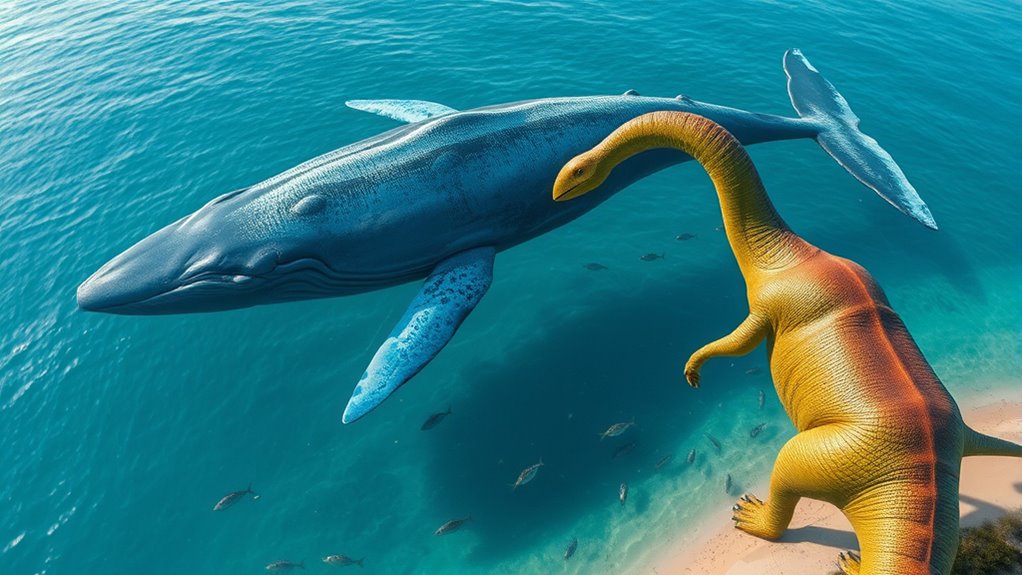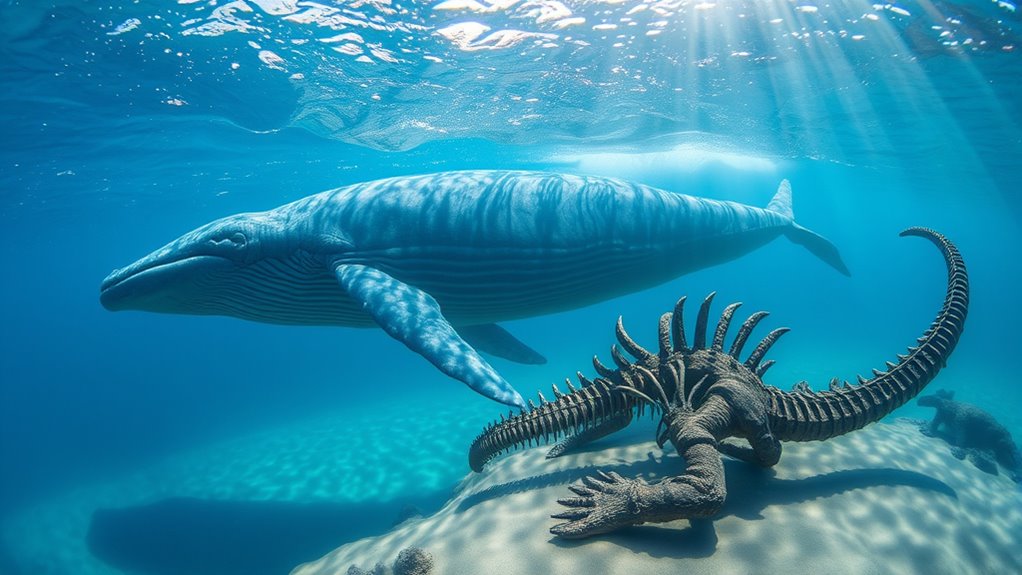Yes, whales are indeed bigger than dinosaurs. The blue whale, for instance, can reach lengths of up to 100 feet and weigh around 200 tons, surpassing even the largest dinosaurs like Argentinosaurus, which stood at about the same length but only weighed around 100 tons. Whales’ streamlined bodies and adaptations for life in water contribute to their impressive size. If you’re curious about how these giants evolved and their role in marine ecosystems, there’s plenty more to explore!
Key Takeaways
- Blue whales can reach lengths of up to 100 feet and weigh around 200 tons, surpassing the largest dinosaurs.
- The largest dinosaurs, such as Argentinosaurus, measured about 100 feet and weighed around 100 tons, making them smaller than blue whales.
- Whales are considered the largest animals ever known, while dinosaurs, despite their impressive size, do not match whales’ overall dimensions.
- The ocean environment has allowed for the evolution of gigantic marine species like the blue whale, which dominate in size and weight.
- While megalodon and other prehistoric marine creatures were large, they remain smaller than modern blue whales, reinforcing whales’ size dominance.

Have you ever wondered just how massive whales really are compared to dinosaurs? When you explore the world of marine mammal size, the contrast between these majestic creatures and the prehistoric sea creatures that once roamed our planet is astonishing. While dinosaurs walked the land and dominated Earth’s surface, the oceans were home to their own colossal giants.
Whales, particularly the blue whale, hold the title for the largest animal ever known to exist. They can reach lengths of up to 100 feet and weigh as much as 200 tons. Just imagine that—it’s like having a school bus swimming beside you. In comparison, some of the largest dinosaurs, like Argentinosaurus, might’ve weighed around 100 tons and stretched about 100 feet long. So, you might think that dinosaurs could hold their own, but when it comes to sheer weight and size, whales take the lead.
Whales, especially blue whales, surpass even the largest dinosaurs in size and weight, showcasing their oceanic dominance.
You might be surprised to learn that while most dinosaur fossils give us glimpses into their massive frames, ancient marine creatures like the megalodon were equally impressive in their own right. This prehistoric shark could reach lengths of over 60 feet, which is still smaller than the blue whale, but it was a formidable predator of its time. While they lived in the same era, the ocean’s depths allowed for a different evolutionary path, leading to the gigantic marine mammals we see today.
Now, if you’re picturing a T-rex towering over a blue whale, it’s essential to remember that these creatures thrived in different environments. The T-rex, with its powerful legs and sharp teeth, was built for land, while whales have evolved over millions of years to master life in water. Their bodies are streamlined for swimming, and their immense size helps them maintain buoyancy in the ocean’s depths. Additionally, the role of color accuracy is fascinating when it comes to how we visualize these enormous creatures in documentaries and displays.
Frequently Asked Questions
What Are the Largest Dinosaur Species Ever Discovered?
The largest dinosaur species ever discovered include the Argentinosaurus, which could reach lengths of over 100 feet, and the massive Patagotitan, weighing up to 70 tons. These prehistoric behemoths roamed the Earth, dwarfing many other species. While you might think of marine giants like blue whales, dinosaurs like these truly redefine size in the animal kingdom. Their sheer scale continues to fascinate scientists and enthusiasts alike, highlighting the diversity of prehistoric life.
How Do Whale and Dinosaur Sizes Compare in Context?
When you think about marine giants, it’s easy to picture colossal creatures gliding through ancient oceans. Whales, especially the blue whale, can reach lengths of over 100 feet, making them the largest animals ever. In contrast, some dinosaurs, like Argentinosaurus, reached similar lengths but were heavier due to their prehistoric proportions. So, while both are massive, whales hold the title for sheer size in the modern world, unlike any dinosaur ever discovered.
Did Dinosaurs and Whales Coexist at Any Point?
No, dinosaurs and whales didn’t coexist. Dinosaurs roamed the Earth during the Mesozoic Era, which ended about 66 million years ago. The first whales appeared much later, around 50 million years ago, during the Eocene Epoch. While both groups include impressive marine giants, their timelines didn’t overlap. You can imagine a world without these massive creatures sharing oceans, as prehistoric coexistence between whales and dinosaurs simply didn’t happen.
What Are the Largest Living Animals Today?
You might wonder what it’s like to swim alongside the largest living animals today. The blue whale, a true marine giant, holds the title for the largest animal ever, reaching lengths of up to 100 feet! These majestic creatures showcase evolutionary size at its most impressive. Other contenders include the fin whale and the sperm whale, but none can compare to the sheer enormity of the blue whale, making the ocean their domain.
How Do Scientists Measure the Size of Ancient Creatures?
Scientists measure the size of ancient creatures using fossil measurement techniques and paleontological reconstruction. They analyze fossilized bones, estimating dimensions based on comparisons with modern animals. You might find them using 3D imaging to create accurate models of skeletal structures. By examining the surrounding geology and sediment, researchers can also deduce how these creatures lived and grew. This combination of techniques helps you visualize the impressive scale of these ancient beings.
Conclusion
In the grand ocean of existence, whales swim like ancient titans, shadows of dinosaurs that once roamed the Earth. Just as the mighty tree stands tall, its roots deep in history, so too do these gentle giants remind us that size isn’t everything. The once-mighty dinosaurs may have ruled the land, but today’s whales reign over the seas, a demonstration to adaptability and change. So, in this vast world, remember: true greatness often lies beneath the surface.









